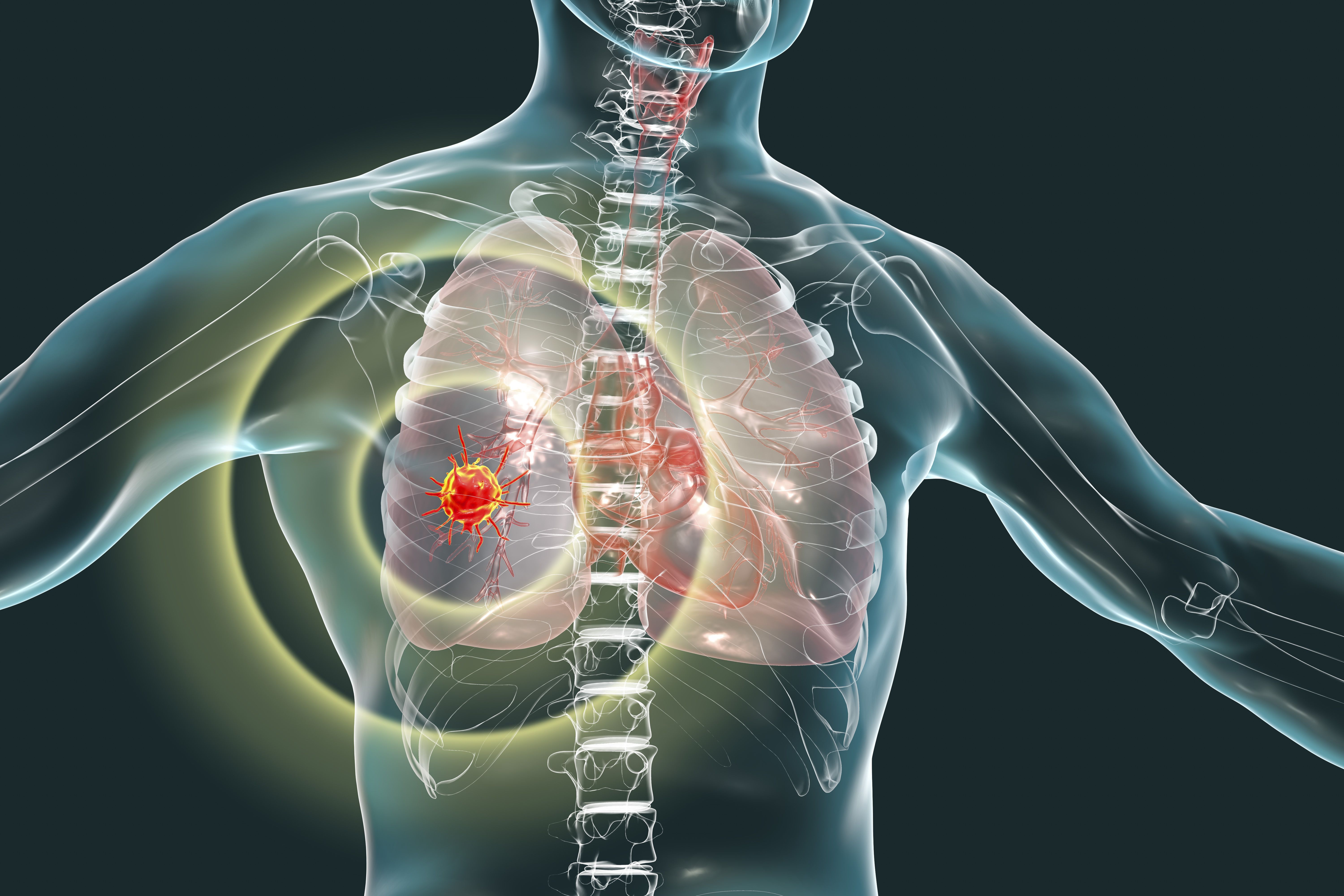HER3-DXd Does Not Yield Improved OS in EGFR-Mutated NSCLC
Results from HERTHENA-Lung02 did not show improved OS with HER3-DXd for patients with EGFR-mutated NSCLC.
Results from HERTHENA-Lung02 did not show improved OS with HER3-DXd for patients with EGFR-mutated NSCLC.

For patients with EGFR mutation–positive locally advanced or metastatic non–small cell lung cancer (NSCLC), patritumab deruxtecan (HER3-DXd) did not elicit improved overall survival (OS), according to results from the phase 3 HERTHENA-Lung02 trial (NCT05338970) presented at the 2025 American Society of Clinical Oncology (ASCO) Annual Meeting.1
The median OS was 16.0 months (95% CI, 13.7-18.7) in the patritumab deruxtecan arm vs 15.9 months (95% CI, 14.6-17.9) in the chemotherapy arm (HR, 0.98; 95% CI, 0.79-1.22). The median follow-up was 18.7 vs 18.6 months in the 2 arms, respectively.
Based on these OS data, Merck previously withdrew its biologics license application seeking FDA approval of patritumab deruxtecan for use in this setting.2
Additional Efficacy Data
Previously reported results from the primary analysis of the HERTHENA-Lung02 trial showed that patritumab deruxtecan significantly reduced the risk of disease progression or death vs chemotherapy. The median progression-free survival (PFS) was 5.8 months with patritumab deruxtecan vs 5.4 months with chemotherapy (HR, 0.77; 95% CI, 0.63-0.94; P =.011). The 9-month probability of PFS was 29% (95% CI, 23%-35%) vs 19% (95% CI, 14%-25%), respectively. The PFS benefit was sustained across most subgroups, including those defined by age, sex, geographic region, brain metastases at baseline, smoking status, and ECOG performance score.
The confirmed objective response rate (ORR) was 35.2% (95% CI, 29.7%-40.9%) with patritumab deruxtecan vs 25.3% (95% CI, 20.4%-30.6%) with chemotherapy. The disease control rate (DCR) was 80.5% (95% CI, 75.5%-84.9%) with patritumab deruxtecan vs 75.8% (95% CI, 70.4%-80.6%) with chemotherapy. The median time to response (TTR) was 1.5 months in each arm and the median duration of response (DOR) was about 5.5 months in both arms.
Intracranial efficacy was evaluated in 105 and 95 patients in the treatment and control arms, respectively. The median intracranial response was 5.4 vs 4.2 months, respectively (HR for intracranial progression, 0.75; 95% CI, 0.53-1.06). The confirmed intracranial ORR was 19.0% (95%, 12.0%-27.9%) and 11.6% (95% CI, 5.9%-19.8%) in the two arms, respectively. The intracranial complete response rate was 12.4% vs 4.2% and the intracranial DCR was 68.6% and 61.1%, respectively. The median intracranial TTR and median intracranial DOR were 2.1 vs 2.6 months and 4.5 vs 4.2 months, respectively.
The safety evaluable population included 290 and 280 patients in the patritumab deruxtecan and chemotherapy arms, respectively. The investigators considered the toxicities to be generally manageable and similar to prior research with the study treatments. Grade ≥3 treatment-related adverse events (TRAEs) occurred in 57.9% vs 46.1% of the treatment and control arms, respectively. Serious TRAEs were reported for 22.4% vs 12.5% of the 2 arms, respectively. There were 4 TRAE-linked deaths in the patritumab deruxtecan arm compared with 1 in the chemotherapy arm. Of note, the incidence of adjudicated interstitial lung disease was 5.2% for the patritumab deruxtecan arm.
HERTHENA-Lung02 Design and Patient Characteristics
The open-label phase 3 HERTHENA-Lung02 trial enrolled patients with locally advanced or metastatic NSCLC harboring an EGFR mutation. Patients had to have disease progression after receiving 1 or 2 prior lines of an FDA-approved EGFR TKI, including a third-generation TKI.3
Patient characteristics were well balanced between the patritumab deruxtecan (n = 293) and chemotherapy (n = 293) arms. The median age across both arms was 64 years (range, 34-86), about 60% of patients were female, and about 60% of patients were Asian. Just under two-thirds of patients were never-smokers, and the median time since initial diagnosis was 24.2 months (range, 2.5-146.1). About two-thirds of patients had an ECOG performance score of 1, with the remainder having an ECOG performance score of 0. About 44% of patients had a history of brain metastasis, with about one-third having brain metastases at baseline.1
The approximate breakdown of EGFR activating mutations was 60% with Ex19del, 39% with L858R, and 1% with dual Ex19del and L858R. Regarding prior EGFR TKIs, three-fourths of patients had previously received only third-generation EGFR TKIs, while one-fourth had received both third- and first/second-generation TKIs. Over 90% of patients had prior osimertinib (Tagrisso).
Patients received patritumab deruxtecan at 5.6 mg/kg (IV) every 3 weeks or platinum-based chemotherapy. Chemotherapy consisted of 4 cycles of pemetrexed plus either cisplatin or carboplatin, followed by optional maintenance pemetrexed in patients whose disease did not progress after the initial 4 combination cycles.3
PFS per blinded independent central review was the primary end point, with secondary end points consisting of OS, investigator-assessed PFS, ORR, DOR, clinical benefit rate, DCR, TTR, intracranial PFS, quality of life, and safety.1
Regarding next steps, Mok said, “Evaluation of the association of biomarkers, including HER3 IHC, with efficacy parameters in HERTHENA-Lung02 and their suitability as a predictive biomarker is ongoing.”
References
- Mok T, Yu H, Lim SM, Patritumab deruxtecan (HER3-DXd) in resistant EGFR-mutated (EGFRm) advanced non-small cell lung cancer (NSCLC) after a third-generation EGFR TKI: The phase 3 HERTHENA-Lung02 study. J Clin Oncol. 2025;43(suppl 17):8506. doi: 10.1200/JCO.2025.43.16_suppl.8506
- Patritumab deruxtecan biologics license application for patients with previously treated locally advanced or metastatic EGFR-mutated non-small cell lung cancer voluntarily withdrawn. News release. Merck. May 29, 2025. Accessed June 1, 2025. https://www.merck.com/news/patritumab-deruxtecan-biologics-license-application-for-patients-with-previously-treated-locally-advanced-or-metastatic-egfr-mutated-non-small-cell-lung-cancer-voluntarily-withdrawn/
- HERTHENA-Lung02: a study of patritumab deruxtecan versus platinum-based chemotherapy in metastatic or locally advanced EGFRm NSCLC after failure of EGFR TKI therapy. ClinicalTrials.gov. Updated January 31, 2025. Accessed June 1, 2025. https://clinicaltrials.gov/study/NCT05338970